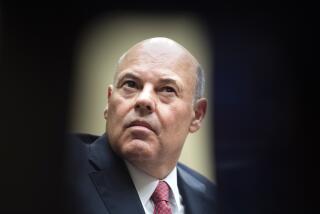Groups Seek Postal Service Reform as Costs Rise, Commerce Changes
WASHINGTON — Less than two months after the U.S. Postal Service raised rates, the nation’s mail monopoly has given notice that it wants to increase them again. With costs rising fast and revenue falling short of expectations, the prospect of pricier postage is merely the latest sign, postal rate commissioners and mailers say, that the agency is in need of far-reaching reform--perhaps privatization.
So pressing is the situation that groups that are traditionally hostile to one another are working together to press Congress for postal reform. In particular, they will push for a presidential commission to address such fundamental questions as: Is the Postal Service’s mission of affordable, universal service still valid? And, what does the country want the postal system to be?
“You’re looking at a postal system that is in an economic death spiral,” said Gene Del Polito, president of the Assn. for Postal Commerce, which represents such direct-marketing and catalog companies as Columbia House, Time Warner and Barnesandnoble.com.
Already, advances in technology and a drive to cut costs are spurring changes among the Postal Service’s customers: Banks are encouraging customers to pay bills online; churches are posting their bulletins on Web sites.
“It’s not as though the Postal Service is the essential communication service anymore,” said Postal Rate Commission member Ruth Goldway, who last year proposed privatizing the service, whose roots stretch back to Benjamin Franklin. “Everyone has telephones. Almost 80% of the population has access to [the] Internet.”
In January, the postal system increased rates an average of 4.6%, with the price of a first-class stamp rising a penny, to 34 cents. But the Postal Service’s Board of Governors, citing prospective losses of $3 billion, announced last month that it would seek another rate increase, likely this summer. Though postal officials have not indicated how much it will be, analysts are anticipating an increase of $6 billion to $7 billion, or about a 10% average rate boost.
Such an increase would significantly harm mail-order catalog companies, small newspapers and magazines, industry officials say. “For a lot of the companies that have had a tough year, it’s probably enough to bring them down to their knees,” said Del Polito, who is helping to organize the Coalition for the Preservation of Universal Mail Service.
Although the coalition, which includes direct marketers, magazines and nonprofit mailers, sees the creation of a presidential commission as a good way to achieve long-term reform, some members believe that immediate change is what’s needed most.
Already, the nonprofit community, which generally cannot pass on rate increases to customers, has begun to find alternatives to the post office. “Community center bulletins are moving biweekly, finding ways to send out e-mail,” said Neal Denton, executive director of the Alliance of Nonprofit Mailers.
*
But underlying the anxiety is the broader issue of what to do about a 900,000-person operation that tries to act as a business but is run as a government monopoly--one that charges only 34 cents to mail a letter, whether it’s from downtown to Capitol Hill or from Capitol Hill to Nome, Alaska.
The Postal Service is trying to be more dynamic. In January, it announced a partnership with Federal Express for air delivery. It has begun to sell advertising space on mail trucks and mail collection boxes, in post office lobbies and on the Postal Service’s Web site. It has ventured into e-commerce, with online bill paying and PosteCS, a service that delivers documents electronically. But it is impossible to say whether these products are making a profit because the agency’s financial information is so “unreliable,” said Bernard Ungar, an analyst for the General Accounting Office.
Postal reform means different things to different organizations. In general, it means giving the agency more flexibility in its operations--including addressing labor cost issues--and in setting rates to meet changing market conditions. Another aspect is limiting its monopoly authority, or even privatization, which is the trend in Western Europe. But industry competitors and customers also want to make sure that reform would prevent the system from throwing its monopoly weight around.
Tad Segal, a spokesman for United Parcel Service, said the Postal Service should focus on cutting costs before it raises rates. He cited a report by the inspector general that identified more than $1 billion in waste, fraud and abuse, and a 1999 General Accounting Office study that concluded the service lost money on its competitive ventures.
“The Postal Service has to shore up its own house,” he said.
*
Critics argue that because the Postal Service, which is mandated to break even, can raise rates to cover costs, it has no incentive to economize. The 1970 law that governs it does not help. For example, the law requires the agency to maintain a national network of offices, many of which are small and unprofitable.
Moreover, labor accounts for 80% of its costs, and retirement, health care and workers’ compensation expenses are difficult to control. Also, with the largest fleet of trucks in the nation, a penny increase in the cost of a gallon of gas boosts expenses by $5.5 million a year.
“It is very clear that the Postal Service cannot be managed under the present statute,” said David Fineman, a postal board governor.
The postal system needs incentives to change its behavior, industry officials say. “A real, live, honest-to-goodness business that didn’t have a government monopoly would recognize that it didn’t have market share and would begin to scale back to something smaller, sleeker,” Denton said.
But it is difficult to scale back when the service is adding 1 million addresses a year to its routes, said George Gould of the National Association of Letter Carriers.
The Postal Service is among those calling for reform because it understands that its economic model “is just outdated,” said Deborah Willhite, a Postal Service senior vice president. “We are extremely susceptible to the marketplace. We have very little flexibility to respond to it.”
More to Read
Sign up for Essential California
The most important California stories and recommendations in your inbox every morning.
You may occasionally receive promotional content from the Los Angeles Times.










